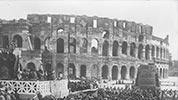Archaeology and Ancient History
Claire's dissertation
Sanitized City, Sanitized History: A study into how the Fascist regime engineered the city centre of Rome in order to create a particular narrative of antiquity
Why did you choose this topic?
The archaeological activities of Mussolini's regime were first introduced to me in a first year lecture and ever since then I wanted to explore the subject further. The use of space to construct narratives and deliberate distortions of history by political regimes had long interested me, and this topic proved to be the perfect combination of these two concepts.
What did you write about?
 Cultural heritage and public archaeological sites have a significant impact upon our ability to conduct scholarly study into the past. They can also have a major influence upon tourists and the general public's perceptions of that past. This is perhaps no more pronounced than in the city of Rome, with its wealth of open and accessible ancient monuments at its centre. However, many of these monuments had become surrounded by and incorporated into a number of densely populated neighbourhoods in the centuries following the 'fall' of the Roman Empire. The popular image of 'Ancient Rome' now, the one in tourists' photographs, is largely a fabrication of the 1930s.
Cultural heritage and public archaeological sites have a significant impact upon our ability to conduct scholarly study into the past. They can also have a major influence upon tourists and the general public's perceptions of that past. This is perhaps no more pronounced than in the city of Rome, with its wealth of open and accessible ancient monuments at its centre. However, many of these monuments had become surrounded by and incorporated into a number of densely populated neighbourhoods in the centuries following the 'fall' of the Roman Empire. The popular image of 'Ancient Rome' now, the one in tourists' photographs, is largely a fabrication of the 1930s.
This study explores how the Italian Fascist regime engineered Rome's cityscape and weaponized archaeology in order to construct their own narrative of history, demolishing whole neighbourhoods in the process. It looks at how Mussolini's regime sought to project their (often contradictory) concept of romanità (roughly 'Romanness') to the Italian people and the world. The relative success of this was measured through an analysis of three key features of the regime's town planning: roads, ruins and piazzas. It also investigates the impact of this upon Rome's dealings with its cultural heritage today.
Ultimately, this study demonstrates that Fascism's romanità was not simply 'backwards-looking', as has sometimes been thought, but fundamental to the regime's claims to be leading Italy into a prosperous and dominant future. A deliberately distorted narrative that discarded with the conventional boundaries of time was necessary to legitimise the regime's claim to power and deterministic approach to history. This distortion still impacts upon the way in which Rome's ancient monuments are presented today.